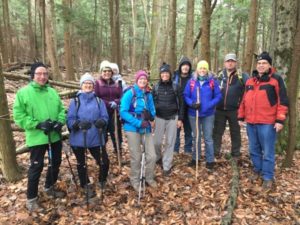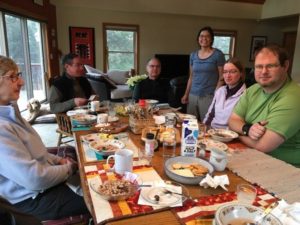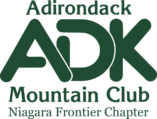After the holidays, this winter hike was enjoyed by 11 hikers braving the brisk 35 degrees at the beginning of this Deer Lick/Zoar Valley hike.  The sun periodically made an appearance to help warm us up throughout the hike.
The sun periodically made an appearance to help warm us up throughout the hike.
The group enjoyed this 3.2 mile hike through old growth hardwood trees, scenic overlooks to the Cattaraugus Creek canyon walls and the crossing of the creek near the Deer Lick Falls.
Hikers were treated to many large mature cherry, hemlock, tulip and maple trees as this property is maintained by the Nature Conservancy. While most leaves have fallen off, tree identification was done by the bark or finding the fallen leaves under the trees.
 After the hike the group was invited to Dave and Wendy’s home to eat 2 different types of corn soup and a boiled cornbread. Dave and Wendy are Seneca traditional knowledge holders and shared information on the origins of corn and various corn foods made from corn grown on their farm. They also shared information on the “One Bowl One Spoon” treaty/wampum belt. This is an agreement/principle between two or more Nations/People for sharing hunting territory/food/environmental resources to take no more than you need. In principle, all People are all eating out of a single dish, which is the environmental resource (hunting, fishing, water, food). One spoon signifies that all People sharing the territory are expected to limit the game/resource they take and to leave enough for others for continued abundance and viability of the resources into the future. The soups, bread and conversations were enjoyed by all. Go to their podcast for more information on the important work the Brays are doing.
After the hike the group was invited to Dave and Wendy’s home to eat 2 different types of corn soup and a boiled cornbread. Dave and Wendy are Seneca traditional knowledge holders and shared information on the origins of corn and various corn foods made from corn grown on their farm. They also shared information on the “One Bowl One Spoon” treaty/wampum belt. This is an agreement/principle between two or more Nations/People for sharing hunting territory/food/environmental resources to take no more than you need. In principle, all People are all eating out of a single dish, which is the environmental resource (hunting, fishing, water, food). One spoon signifies that all People sharing the territory are expected to limit the game/resource they take and to leave enough for others for continued abundance and viability of the resources into the future. The soups, bread and conversations were enjoyed by all. Go to their podcast for more information on the important work the Brays are doing.
– Submitted by Trip Leaders Dave and Wendy Bray
The group not only enjoyed the outing, the socializing and the delicious food, but the lesson learned from Dave and Wendy will be a lasting memory. Their generous presentation of homemade food, hospitality and the pertinent metaphor of One Bowl One Spoon was a reminder of the necessity to respect each other and to work to lessen our impact on the environment from eco-safe farm practices to our own diets. Many thanks to David and Wendy for being an example of conservation in practice.
– Submitted by Mary Schraven
